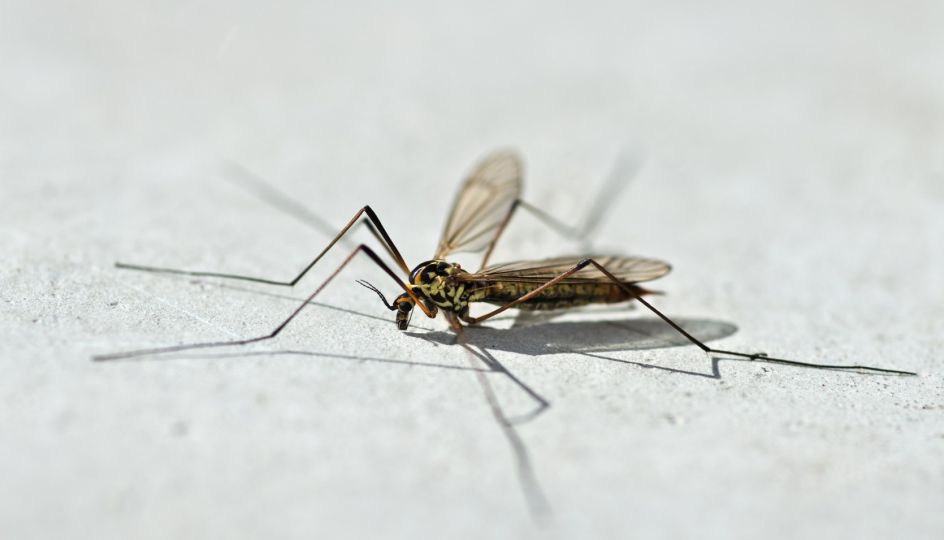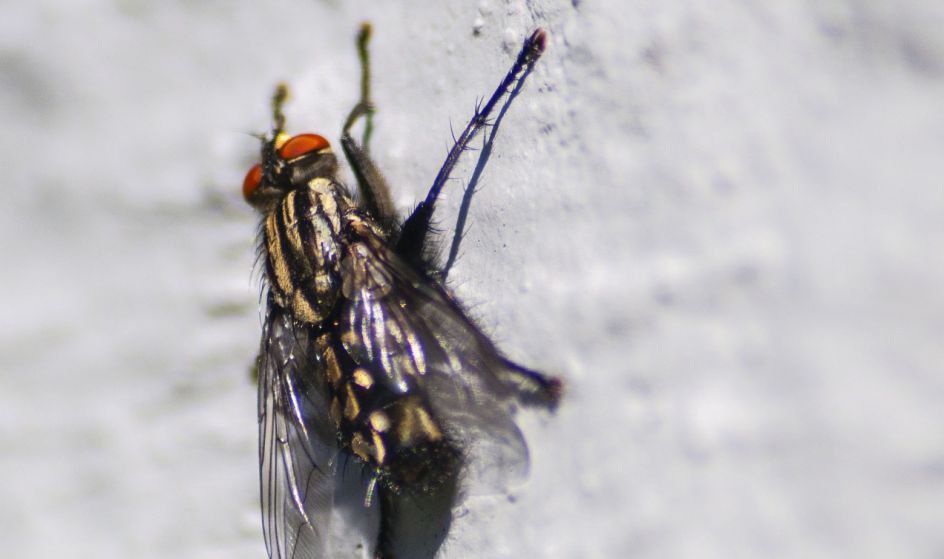There it is, splattered all over your lovely wallpaper - a dead insect! Especially mosquitoes often don't leave us any other option but to swat them on the wall. On wallpapers, this creates an unsightly and underestimated problem, but one that can be avoided.
The seasons do have some impact on the likelihood of these unwanted splodges, but insects of all sorts find their way into the house (and onto your beautiful wallpaper) in spring, summer, autumn and winter alike. Mossies, spiders, bugs, wasps - there are plenty of possible culprits, not all of them immediately recognisable. You might find a number of substances on your walls, from red, blue or green "blood" to sticky matter of various consistencies. When removing dead insects or their remains, great care should be taken to avoid damaging the wallpaper surface and spreading the stain further.
More often than not, insects just take a little break on your wallpaper and leave a miniature "present" behind. These so-called "fly specks" then dry into the paper, to be discovered much later. In those cases, it is important to remember: Don't use a sledgehammer to crack a nut - approach the issue with careful consideration.
This guide will explain how you can remove fresh or dried insect-related marks gently in order to avoid damaging your wallpaper, and how to prevent them in the first place. That's great for the wall décor as well as for the insects - after all, they are living beings, too.

General Information
We recommend keeping the inserts specifying the characteristics of the designer and patterned wallpapers you bought from our Wallpaper Shop somewhere safe, in case you need to refer to them later on. This is extremely helpful if you need to remind yourself of your newly acquired wallpaper's cleaning and care features, and you can swiftly find out if it is water-resistant, wash-resistant, highly wash-resistant, scrub-resistant or highly scrub-resistant. Once equipped with that knowledge, you can approach any insect-related stains or damages appropriately. There is, of course, always a certain amount of risk involved, but we will try to minimise this via the information provided in this guide.
Generally speaking: Glossy, shimmering, metallic, foil, embossed, and structured wallpapers or those adorned with decorative elements should never be tackled with sharp objects, household or office erasers, or brushes. Chemical stain removers designed specifically for wallpaper or for particular stains (e.g. blood), household detergents, laundry detergents, vinegar, citric acid and baking powder or sodium-bicarbonate are also taboo. Only use water, perhaps with a drop of washing-up liquid to create a soapy solution.
Our Wallpaper Shop offers a large range of design wallpapers with special surfaces made of textile or natural materials. The majority of these wallpapers is water-resistant, but not washable, which means that these surfaces can only be treated with a damp (not wet!) cloth. This will protect the form and structure in the treated area.

How to remove fresh insect stains and remains
Some people are afraid of insects (especially spiders!), others don't want to be bitten or cannot stand the constant high-pitched noise mosquitoes make. So as soon as the insect sits still, it's flattened. It might fall off the wall, leaving behind blood and other unidentifiable substances, often spread across your high-quality wallpaper by the fly swatter.
To get rid of fresh insect stains or remains, just follow these steps:
- Use a bit of tissue or kitchen paper to carefully remove the remnants of the insect from the wall. Make sure you do not rub.
- Now remove liquid elements like blood with another clean tissue. You may want to slightly dab the area in question - please be very careful.
- If there traces remain on the wall, use a microfibre cloth (or alternatively a bit of sponge cut to size), dampen it with water and gently dab the area - do not rub! Carbonated/fizzy water is also suitable for this task. The carbon dioxide works as a mild solvent.
- If you know the cleaning characteristics of the wallpaper (which would be the best possible situation), you can adapt the method of cleaning to the options washable, highly washable, scrub-resistant or highly scrub-resistant. You can find more detailed information in our comprehensive Blog Guide Washable Wallpaper - a clean solution, which explains which detergents and tools to use for which wallpaper types.
Tip:
If you don't have the insert listing the cleaning characteristics of your wallpaper any longer, you can search the model in our on-line Wallpaper Shop to access this information (just as long as you remember the name!). Even for discontinued models, you'll find the wallpaper characteristics in the article descriptions

How to prevent insect stains on your wallpaper
Let's state the obvious first: Resist the temptation to squash the poor insect and use the two other methods below to remove it from the wallpaper. Of course, the urge to kill is often based on a deep-seated sense of disgust and fear. But for some strange reason, that doesn't apply to all insects. Not many of us can just squash a pretty little ladybird. Approach the situation with the same respect for the insect (and your exclusive wallpaper!) as you would for any type of creepy crawly - even the "cute" ones. Forget about your fear and disgust for a minute, or simply ask a family member or any other person present to remove it. If you feel able to do it yourself, so much the better!
For all insects that move by crawling, or fly very slowly, e.g. bugs, bees, spiders etc., get a piece of newspaper and slowly push it under the little animal. It will either crawl or fall onto the newspaper (or the floor). Once it is safely placed on the newspaper, calmly take it to an open window and let it go.
As an alternative for those cases where the newspaper trick doesn't work - or if you simply feel unable to proceed in this manner - you can always use your vacuum cleaner to remove the insect from the wall. This, too, requires a bit of a gentle touch. Avoid placing the suction nozzle directly on the wallpaper or moving it around as this can cause damages and additional stains. Point the suction tube extension at the insect, keeping some distance, and then turn the vacuum cleaner on. Most of the time, the animal will be sucked in before it knows what hit it.
Flying insects are less easy to remove from the wall for good, especially mosquitoes or moths. Vacuum cleaners or newspapers are no match for them as they will simply fly from one wall to another.
You won't get rid of them altogether, especially during the summer, but as long as there aren't too many of them, it shouldn't be too much of a problem. They might leave tiny marks on the wall, but those are so small as to be irrelevant/invisible. If all else fails, there is always insect spray - a tried and tested method to get rid of the little blighters for good, but please make sure you follow the instructions on the label. Do not breathe in the spray, leave the room in question and keep all windows and doors shut for the time stated. Don't forget to give the room a good airing afterwards. Use the vacuum cleaner to remove the dead insects from the floor or furnishings.

The best solution is to make sure that the insects don't find their way into your home in the first place. Many insects are magically drawn to smells, attractants, sweet liquids and foodstuffs as well as light. This is how to prevent insects from coming into your home:
- Insect screens for windows are one of the safest methods to keep insects away during the warm summer months.
- If you are in a room after sunset and the light is on, it is best to leave the windows shut. Even the light emanating form the TV will attract moths and mosquitoes.
- Throughout the year, don't leave organic waste (e.g. for the compost) in your kitchen and make sure you get rid of fermenting or mouldy food; if available, put it straight into your green bin.
- During the winter, make sure that rooms aren't too cold and air them regularly, as a cold and damp room climate attracts spiders.
Conclusion:
If you can resist the temptation to swat insects and try our suggested solutions instead, you'll spare yourself the tedious task of removing stains. The "newspaper method" is a true win-win situation. The insects (part of the food chain!) stay alive, your lovely wallpaper remains unscathed and you have more time for the fun things in life!
Remember: The effort and annoyance connected with removing a dead insect from the wall is far greater than that of removing it and setting it free. All it takes is a bit of willpower to get over one's fear and/or disgust. Simply think of this: You are faced with a tiny animal that is completely at your mercy and has only a tiny faction of your strength and size. It's not like you are confronted by a huge bear ready to tear you apart! Are you smiling yet? See, just take it with a pinch of humour and pretend that even less attractive creepy-crawlies are sweet little ladybirds...

